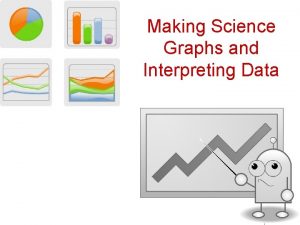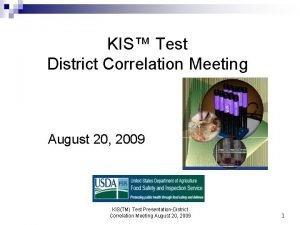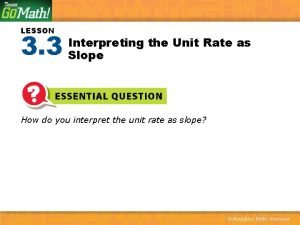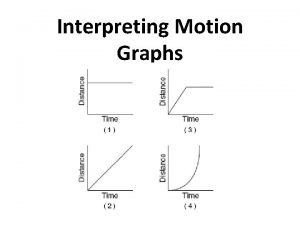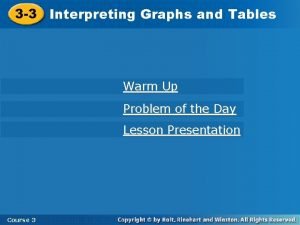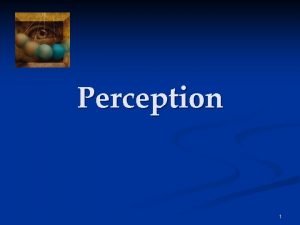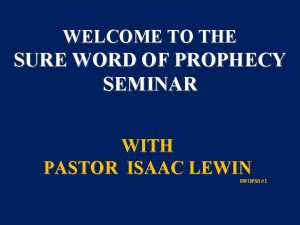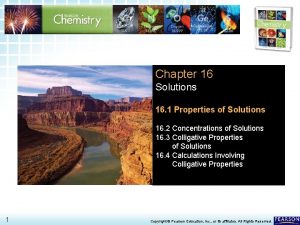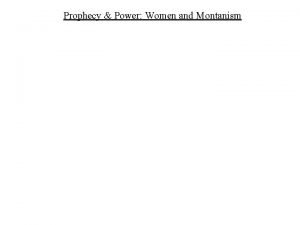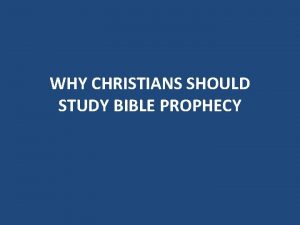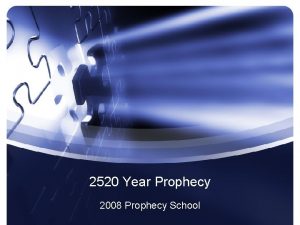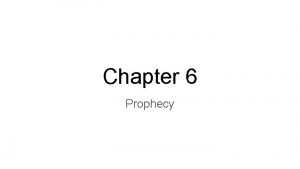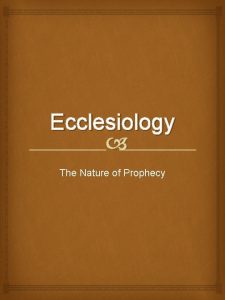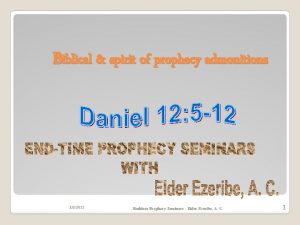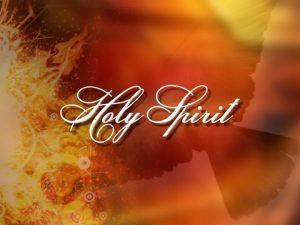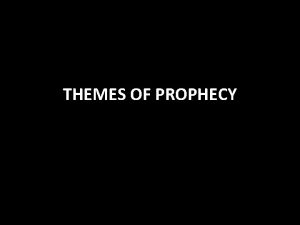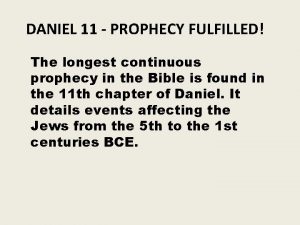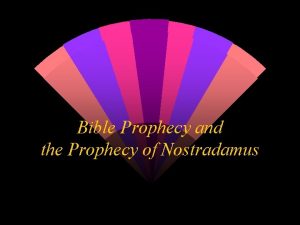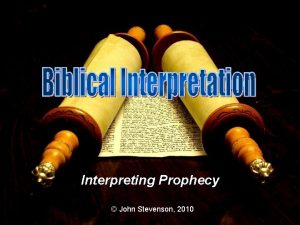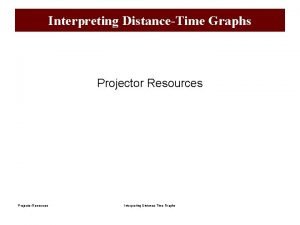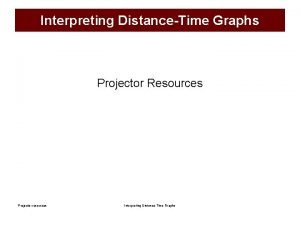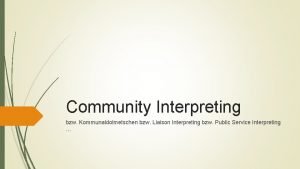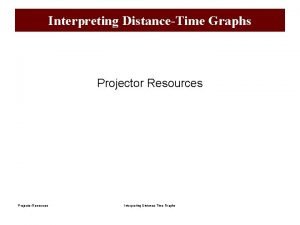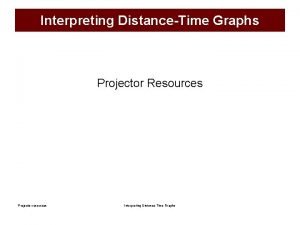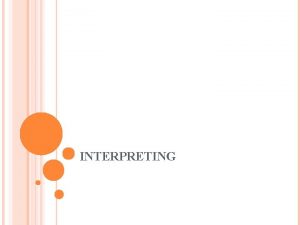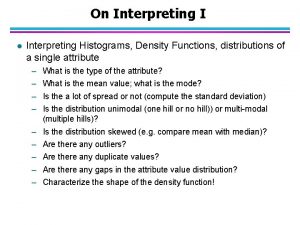Interpreting Prophecy I What is prophecy A The





















































- Slides: 53


Interpreting Prophecy I. What is prophecy? A. The definition of the word prophecy. Prophecy is the supernatural ability to receive a message initiated by God and the grace to speak it forth.

1. Prophecy is to be initiated by God (Jer. 23: 16 -22; Ezek. 13: 1 -3). 2. Prophecy is God speaking to His people through a person (Ex. 4: 15 -16; 6: 287: 2).

B. The two main types of prophecy 1. Forth-telling (Heb. 1: 1 -2 a). Forthtelling is speaking forth a declarative message from God that does not involve prediction. 2. Foretelling (Amos 3: 7 -8). Foretelling is speaking a predictive word from God dealing with the future.

II. Why is it so important to study the prophets? A. The Old Testament prophets were God’s vehicle through which to speak to His people (Heb. 1: 1 -2 a; II Kgs. 17: 13).

B. The Old Testament prophets prophesied concerning Christ and the Church. 1. Jesus declared that the entire Old Testament was about Him (Luke 24: 2527, 44 -49; Matt. 5: 17 -18). 2. The Early Church recognized that the main message of the prophets was Jesus (Acts 7: 51 -53).

3. Paul was aware of the fact that the prophets spoke of Christ and the Church (Rom. 1: 1 -3; Rom. 16: 25 -27).

C. The New Testament writers made extensive use of the Old Testament prophets. D. The Books of the Prophets make up over one fourth of the Bible.

III. What are some of the names and titles of prophets in the Old Testament? There are various names ascribed to the prophets in the Old Testament. A. Man of God (I Sam. 9: 6; I Kgs. 12: 22; 13: 1; II Kgs. 5: 8). Even though there were female prophets as well, this title emphasized the separation of these individuals unto God and their upright lifestyles.

B. Seers (I Sam. 9: 9; II Sam. 24: 11; II Kgs. 17: 13; I Chr. 26: 28; 29: 29; II Chr. 16: 7, 10; 33: 18; Is. 29: 10; 30: 10; Amos 7: 12). This title indicates that these individuals saw into the ways of God, had foresight into the workings of God and had vision in regard to the plan of God.

C. Messengers of the Lord (II Chr. 36: 1516; Is. 42: 19; Mal. 3: 1). This title highlights the fact that these individuals were ambassadors and official representatives of God entrusted with a message from God to be delivered to His people.

D. Servants (II Kgs. 9: 7; 17: 13, 23; 21: 10; Ezra 9: 11; Jer. 7: 25; 25: 4; 29: 29; 44: 4; Ezek. 38: 17; Dan. 9: 6, 10). This title reflects the nature of all of God’s ministers who are love-slaves to the Lord and servants to the people of God.

E. Prophets (Ex. 4: 15 -16; 7: 1 -2; Jer. 15: 19; II Pet. 1: 21). The prophet was to be a mouth piece for the Lord. God would give His word to them and they would speak it to the people.

IV. What is the background and development of the ministry of the prophet in the Old Testament? A. The concept of the prophetic ministry has its roots in the patriarchs. 1. In early times a spirit of prophecy came upon godly men such as Enoch and Noah (Jude 14 -15; Gen. 9: 25 -27).

2. Abraham was the first man in the Old Testament to be called a prophet (Gen. 20: 7; Ps. 105: 9 -15). 3. Isaac and Jacob were also used by God relative to prophecy (Gen. 27, 48 -49; Heb. 11: 20 -21). 4. Joseph was also anointed to prophesy in relation to his sons (Gen. 50: 24; Heb. 11: 22).

B. The prophetic office was established and defined by two main figures in the Old Testament—Moses and Samuel. 1. Moses laid the foundation for this ministry in the Old Testament. a. He provided the definition of a prophet and the criteria for testing this ministry (Deut. 13: 1 -5; 18: 19 -22).

b. He provided a mature example of the prophetic ministry (Num. 12: 6; Deut. 18: 15 -18; 34: 10 -12).

2. Samuel developed this ministry to a place of prominence in Israel. a. He functioned on a high level of prophetic ministry (I Sam. 3: 19 -21). b. He became the first of a new order of prophets (Acts 3: 24; 13: 20).

c. He established schools of the prophets where the prophetic gifts would be cultivated and developed (I Sam. 10: 5, 10; 19: 20). d. He laid the foundation for the prophet’s ministry to kings and governmental leaders (I Sam. 10: 1; 16: 13).

C. The prophetic office remained strong through Malachi. Even though the words of the prophets were often disregarded, they served as a conscience to the nation. D. The period of the Old Testament ends with no strong prophetic voice and what is referred to as the 400 “silent years. ” The silence is broken with the “voice of one crying in the wilderness” (Mark 1: 3).

V. What are the differences in expression among the various prophets in the Old Testament? A. There were prophets of guidance. Many of the prophets could be classified as prophets of guidance. Moses, Samuel, Elijah and Elisha would fall into this category. . .

These prophets operated primarily in realms of guidance, word of wisdom, word of knowledge, miracles and declaring God’s word and His will to His people. These were people who were in close relationship to God and were, as a result, consulted in areas of guidance and direction. Some of these were prophets of Scripture, but most of them were only oral prophets.

B. There were prophets of vision. Some of the prophets in the Old Testament could be classified as prophets of vision. Ezekiel, Daniel and Zechariah are the main examples of this type. These prophets are characterized as those who “saw” the Word of the Lord. God gave them visions and they recorded what they saw…

In most cases what they saw had to do with the future of people and nations. The Revelation of John reflects this same type of prophetic ministry.

C. There were prophets of testimony. A few prophets were prophetic in an unusual way. The lives of these prophets became a testimony and the principle message that they carried. Jonah’s principle prophecy was his three days and three nights’ experience in the belly of the whale (Matt. 12: 39 -41; 16: 4; Luke 11: 29 -32)…

Although Hosea would also fall into other categories because of his prophetic words, he also lived a life of prophetic actions that were to speak to the nation (Hosea 1).

D. There were prophets of Scripture. The prophets of Scripture are the ones with which we are the most familiar because of their writings that have come down to us. These prophets did no miracles; they simply spoke the Word of the Lord. These prophets include two categories, the Major Prophets and the Minor Prophets.

The classification of these prophets has nothing to do with the importance of their message. The classification is only given based on the volume of the prophecies that we have from them.

1. The Major Prophets (or former prophets, as they are sometimes called) include Isaiah, Jeremiah, Ezekiel and Daniel. 2. The Minor Prophets (or latter prophets, as they are sometimes called) include all of the rest of the prophetic books from Hosea to Malachi.

VI. What are some important guidelines in understanding prophecy? A. It is important to understand the historical context of the prophecy. We can do this by asking some of these questions. a. When was the prophecy given? b. Who was the prophet?

c. What is the historical context into which it was spoken? d. For whom was the prophecy intended? e. What meaning did it have for those who first heard it? f. What was God’s purpose in giving the prophecy? g. What is the result that God was trying to produce with this prophecy?

B. It is important to discern if the prophecy is declarative or predictive in nature. Much of the material found in the prophetic books of the Bible came in the form of a message from God to a people who needed adjustment, encouragement or rebuke. In this case the significance of the passage is not in its application to some future event but in its instructive nature about God and His expectations of His people.

Other portions are clearing predictive and have to do with the future. This look into the future can be for the purpose of promise, warning, blessing or judgment.

C. It is important to discern if the prophecy is conditional or unconditional in nature.

D. It is important to discern if the prophecy is to be taken literally or figuratively. The bulk of the prophetic material in the Bible is meant to be interpreted literally. However, there are portions that are obviously very figurative and symbolic. The prophets of vision are particularly figurative in their language. They use the language of the symbol and therefore must be interpreted with the guidelines discussed under Lesson 17 and 18.

E. It is important to understand that prophets are noted for speaking in hyperbole or exaggerated terminology for the purpose of a radical effect. The language of the prophet is the language of heightened emotion. As a result there is a tendency to use hyperbole for the sake of emphasis. If one is not aware of this speaking style the passage might appear to be a falsehood and one might come to the conclusion that the prophet is lying (Jer. 4: 23 -27).

F. It is important to discern whether or not the prophecy has multiple applications. 1. Many of the prophetic words of the Bible have more than one application. i. The historical application. Does this prophecy have a literal and historical meaning and application to the times in which the prophet spoke?

ii. The prophetic application. Does this prophecy have further meaning and application relative to the First Coming of Christ and the Church? Does the prophecy have to do with the future of nations and people groups?

iii. The ultimate application Does this prophecy have an ultimate meaning and application for those living in the last days prior to the Second Coming of Christ?

2. A good example of multiple applications is the prophecy of Joel found in Joel 2: 28: 32. a. The historical or local application. When Joel gave this prophecy it was intended to mean something in his literal and historical setting to the people to whom he spoke. The people of Judah were going to experience a natural judgment for their sins (Joel 1: 15; 2: 1, 11, 31: 3: 14).

b. The prophetic application. When Joel gave this prophecy he also directed their attention to a season of outpouring and visitation that would come to them in connection with the coming of the Messiah (Joel 2: 28 -32). In fact the apostles in the Book of Acts applied the verses in Joel to the experience that they had on the Day of Pentecost when God poured out His Spirit and visited His people in such a dramatic way (Acts 2: 17 -21).

c. The ultimate application When Joel gave this prophecy he also directed their attention to the days immediately preceding the Second Coming of Christ and the Day of the Lord. When you read this passage carefully, not everything in this passage applies to what transpired on the Day of Pentecost…

The prophecy included may natural signs that in other portions of the Scripture associated with the end times (e. g. wonders in heaven, signs in the earth, sun turned to darkness, moon to blood).

G. It is important to recognize the nonsystematic nature of most prophetic utterances. 1. Prophets did not always prophesy in a logical progression of thought. The prophecies of any given prophet may be a compilation of bits of fragmentary revelation.

2. Prophets did not always prophesy events in chronological order. The prophecies of any given prophet may refer to future events in random order.

H. It is important to determine how to view the predictive aspects of the prophecy. “In dealing with predictive prophecy the interpreter must ultimately come to grips with the problem of fulfillment. He must answer the questions: ‘Who or what was the prophet actually speaking of? ’ and ‘When is the prophecy actually fulfilled? ’ The following are some suggestions in applying this guideline:

1. If the prophecy has been fulfilled, it should be studied in connection with materials that clearly indicate its fulfillment.

2. If the prophecy has been partially fulfilled, the interpreter should search for the reason. Could it be that the hearers were only partially obedient? Or could it be that the prophecy, though having only one sense, may have more than one fulfillment?

3. If the prophecy is yet unfulfilled, the interpreter must proceed with caution in determining its eschatological significance. To begin with, he should look for interpretive clues based on the clear teaching of the rest of Scripture. Then he should determine the time element by using the questions given in the Chronometrical Principle.

I. It is important to remember that Scripture does not contradict itself. If another passage of scripture appears to contradict your interpretation of a prophecy one of two things must be done. 1. You must explain why that passage does not contradict your interpretation of the prophecy.

2. You must re-evaluate your interpretation of this passage in light of other clear passages of Scripture.

J. It is important to apply the other hermeneutical principles to the passage under consideration (See Conner/Malmin pages 154 -157). This would be particularly true of the breach principle, the covenantal principle, the ethnic division principle, the chronometrical principle and the symbolic principle.

 Cái miệng nó xinh thế chỉ nói điều hay thôi
Cái miệng nó xinh thế chỉ nói điều hay thôi Các châu lục và đại dương trên thế giới
Các châu lục và đại dương trên thế giới Bổ thể
Bổ thể Từ ngữ thể hiện lòng nhân hậu
Từ ngữ thể hiện lòng nhân hậu Tư thế ngồi viết
Tư thế ngồi viết Giọng cùng tên là
Giọng cùng tên là Làm thế nào để 102-1=99
Làm thế nào để 102-1=99 Thơ thất ngôn tứ tuyệt đường luật
Thơ thất ngôn tứ tuyệt đường luật Alleluia hat len nguoi oi
Alleluia hat len nguoi oi Hươu thường đẻ mỗi lứa mấy con
Hươu thường đẻ mỗi lứa mấy con Diễn thế sinh thái là
Diễn thế sinh thái là đại từ thay thế
đại từ thay thế Vẽ hình chiếu vuông góc của vật thể sau
Vẽ hình chiếu vuông góc của vật thể sau Công thức tính độ biến thiên đông lượng
Công thức tính độ biến thiên đông lượng Tỉ lệ cơ thể trẻ em
Tỉ lệ cơ thể trẻ em Thế nào là mạng điện lắp đặt kiểu nổi
Thế nào là mạng điện lắp đặt kiểu nổi Lời thề hippocrates
Lời thề hippocrates Vẽ hình chiếu đứng bằng cạnh của vật thể
Vẽ hình chiếu đứng bằng cạnh của vật thể Phản ứng thế ankan
Phản ứng thế ankan Quá trình desamine hóa có thể tạo ra
Quá trình desamine hóa có thể tạo ra Môn thể thao bắt đầu bằng từ đua
Môn thể thao bắt đầu bằng từ đua Hát kết hợp bộ gõ cơ thể
Hát kết hợp bộ gõ cơ thể Khi nào hổ con có thể sống độc lập
Khi nào hổ con có thể sống độc lập điện thế nghỉ
điện thế nghỉ Các loại đột biến cấu trúc nhiễm sắc thể
Các loại đột biến cấu trúc nhiễm sắc thể Thế nào là sự mỏi cơ
Thế nào là sự mỏi cơ Trời xanh đây là của chúng ta thể thơ
Trời xanh đây là của chúng ta thể thơ Voi kéo gỗ như thế nào
Voi kéo gỗ như thế nào Thiếu nhi thế giới liên hoan
Thiếu nhi thế giới liên hoan Phối cảnh
Phối cảnh Một số thể thơ truyền thống
Một số thể thơ truyền thống Thế nào là hệ số cao nhất
Thế nào là hệ số cao nhất Sơ đồ cơ thể người
Sơ đồ cơ thể người Tư thế ngồi viết
Tư thế ngồi viết Số nguyên tố là gì
Số nguyên tố là gì đặc điểm cơ thể của người tối cổ
đặc điểm cơ thể của người tối cổ Các châu lục và đại dương trên thế giới
Các châu lục và đại dương trên thế giới Mật thư anh em như thể tay chân
Mật thư anh em như thể tay chân Tư thế worm breton là gì
Tư thế worm breton là gì ưu thế lai là gì
ưu thế lai là gì Thẻ vin
Thẻ vin Making science graphs and interpreting data
Making science graphs and interpreting data Kis interpreting
Kis interpreting Interpreting the unit rate as slope lesson 3-3 answer key
Interpreting the unit rate as slope lesson 3-3 answer key Interpreting motion graphs
Interpreting motion graphs Chapter 6:1 using medical abbreviations
Chapter 6:1 using medical abbreviations How to interpret p value
How to interpret p value Ferris
Ferris Interpreting two way tables
Interpreting two way tables Isaiah 60 prophecy
Isaiah 60 prophecy Selecting organizing and interpreting information
Selecting organizing and interpreting information Similically
Similically Interpreting graphics use with section 16.1 answers
Interpreting graphics use with section 16.1 answers









































